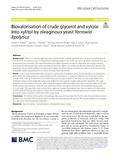JavaScript is disabled for your browser. Some features of this site may not work without it.
| dc.contributor.author | Prabhu, Vinayak Ashok | |
| dc.contributor.author | Thomas, Dominic J. | |
| dc.contributor.author | Ledesma-Amaro, Rodrigo | |
| dc.contributor.author | Leeke, Gary A. | |
| dc.contributor.author | Medina, Angel | |
| dc.contributor.author | Verheecke-Vaessen, Carol | |
| dc.contributor.author | Coulon, Frederic | |
| dc.contributor.author | Agrawal, Deepti | |
| dc.contributor.author | Kumar, Vinod | |
| dc.date.accessioned | 2020-06-08T15:20:21Z | |
| dc.date.available | 2020-06-08T15:20:21Z | |
| dc.date.issued | 2020-06-03 | |
| dc.identifier.citation | Prabhu AA, Thomas DJ, Ledesma-Amaro R, et al., (2020) Biovalorisation of crude glycerol and xylose into xylitol by oleaginous yeast Yarrowia lipolytica. Microbial Cell Factories, Volume 19, Article number 121 | en_UK |
| dc.identifier.issn | 1475-2859 | |
| dc.identifier.uri | https://doi.org/10.1186/s12934-020-01378-1 | |
| dc.identifier.uri | http://dspace.lib.cranfield.ac.uk/handle/1826/15482 | |
| dc.description.abstract | Background Xylitol is a commercially important chemical with multiple applications in the food and pharmaceutical industries. According to the US Department of Energy, xylitol is one of the top twelve platform chemicals that can be produced from biomass. The chemical method for xylitol synthesis is however, expensive and energy intensive. In contrast, the biological route using microbial cell factories offers a potential cost-effective alternative process. The bioprocess occurs under ambient conditions and makes use of biocatalysts and biomass which can be sourced from renewable carbon originating from a variety of cheap waste feedstocks. Result In this study, biotransformation of xylose to xylitol was investigated using Yarrowia lipolytica, an oleaginous yeast which was firstly grown on a glycerol/glucose for screening of co-substrate, followed by media optimisation in shake flask, scale up in bioreactor and downstream processing of xylitol. A two-step medium optimization was employed using central composite design and artificial neural network coupled with genetic algorithm. The yeast amassed a concentration of 53.2 g/L xylitol using pure glycerol (PG) and xylose with a bioconversion yield of 0.97 g/g. Similar results were obtained when PG was substituted with crude glycerol (CG) from the biodiesel industry (titer: 50.5 g/L; yield: 0.92 g/g). Even when xylose from sugarcane bagasse hydrolysate was used as opposed to pure xylose, a xylitol yield of 0.54 g/g was achieved. Xylitol was successfully crystallized from PG/xylose and CG/xylose fermentation broths with a recovery of 39.5 and 35.3%, respectively. Conclusion To the best of the author’s knowledge, this study demonstrates for the first time the potential of using Y. lipolytica as a microbial cell factory for xylitol synthesis from inexpensive feedstocks. The results obtained are competitive with other xylitol producing organisms. | en_UK |
| dc.language.iso | en | en_UK |
| dc.publisher | BMC (part of Springer Nature) | en_UK |
| dc.rights | Attribution 4.0 International | * |
| dc.rights.uri | http://creativecommons.org/licenses/by/4.0/ | * |
| dc.subject | Glycerol | en_UK |
| dc.subject | Xylose | en_UK |
| dc.subject | Yarrowia lipolytica | en_UK |
| dc.subject | Biotransformation | en_UK |
| dc.subject | Xylitol | en_UK |
| dc.title | Biovalorisation of crude glycerol and xylose into xylitol by oleaginous yeast Yarrowia lipolytica | en_UK |
| dc.type | Article | en_UK |
| dc.identifier.cris | 27188000 | |
| dc.date.freetoread | 2020-06-08 |
Files in this item
The following license files are associated with this item:
This item appears in the following Collection(s)
-
Staff publications (SWEE) [2827]

